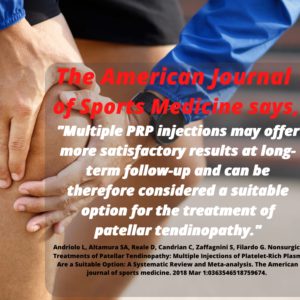 Patellar Tendinopathy
Patellar TendinopathyHave you been diagnosed with patellar tendinopathy? If so, your condition relates to the tendon that passes from the large muscle at the front of the thigh and over the kneecap (patella) to connect to the shinbone.
When someone has knee pain from a tendon problem or other causes, conservative self-management is usually the next step, or a doctor may recommend a brace, wrap, and/or anti-inflammatory medication. These treatments may keep down swelling down and possibly relieve some pain. However, any actual injury is not repaired with these conventional measures.
After a few weeks of rest, once you are active again, you may still experience problems with pain and instability. Repair is needed. Fortunately, Regenerative Orthopedics is an available solution that can repair the tendons and any involved ligaments. Plus, it is non-surgical.
Before we go on, let’s talk about the difference between tendinitis and tendinosis:
The Journal of the American Academy of Orthopaedic Surgeons explains patellar tendinopathy like this: “The main problem in patellar tendinopathy is tendinosis, which is a degenerative disorder rather than an inflammatory disorder; therefore, the other popular term for this disease, tendinitis, is not appropriate.”
Regenerative treatments are needed to repair and regenerate the degenerated soft tissue.
Cortisone injections may help to calm down the inflammation and pain, but cortisone can make the tendon weaker. A recent study on the effect of dexamethasone (a type of cortisone injection) on the patellar tendon showed that dexamethasone had a “paradoxical” effect or changed the tendon stem cells into non-tendon tissue which weakened the tendon. Keep in mind then, that if cortisone is recommended, that while it may calm down inflammation, the injection could weaken rather than strengthen the tendon. (2)
Unfortunately, with a tendon injury, the structure is already weakened. Plus, once it is weakened or damaged through injury or degenerative wear and tear, the knee becomes unstable. Stability needs to be regained, and Regenerative Orthopedics can stabilize and repair the soft tissue structures.
In the Annals of Translational Medicine (3), taping for the purpose of stabilizing the patella was discussed. “Patellar taping is commonly used in conjunction with manual and exercise therapies in the management of patellofemoral pain syndrome. Taping is predominately used to help decrease pain. Other studies show it can also help with patellar alignment and muscle activation. As patellar hypermobility has been shown as a predisposing factor for developing patellofemoral pain syndrome, taping can be indicated to promote patellar positioning and decrease pain. . . Overall, the effects of taping, are conflicting,…short-term it can be helpful with acute management of symptoms with functional activity.”
The goal of taping is to get the patella back into place, and to stabilize it temporarily. It is not reparative. Regenerative Orthopedics can stabilize the patellar, get it back in alignment, and resolve the pain. Regenerative Orthopedics is reparative.
Surgery may help the condition, but the downtime is very long. Researchers in the medical journal Orthopedics found that open surgery and arthroscopic techniques achieved similar satisfactory results but the average time to return to play was 5.6 months and 5 months, respectively (4). But keep in mind, there is also the possibility that surgery may not work.
Why not choose a non-surgical option that results in repair? Plus, effective Regenerative Orthopedics does not require the downtime of surgery. Movement is encouraged!
The Journal of Experimental Orthopaedics examined the use of Prolotherapy in ten different studies for tendinopathies and found: “Among all ten studies, no serious adverse events were reported. Based on this limited set of studies, there seems to be some evidence that…Prolotherapy may be an effective treatment option to treat pain and to improve function in patients with Chronic Patellar Tendinopathy.” (5)
PRP, another form of Regenerative Orthopedics, may also be warranted depending on the severity of the knee condition and for patellar tendinopathy. Do researchers recommend it? Doctors looking for a non-surgical options to treat patellar tendinopathy concluded in the American Journal of Sports Medicine: “Eccentric exercises may seem the strategy of choice in the short-term, but multiple PRP injections may offer more satisfactory results at long-term follow-up and can be therefore considered a suitable option for the treatment of patellar tendinopathy.”(6)
Regenerative Orthopedics is a successful non-surgical solution for many knee pain conditions, including patellar tendinopathy. If you are suffering from knee pain, call us today. We are more than happy to help you resolve your pain and get you back to what you love quickly and with improved knee function.
1 Figueroa D, Figueroa F, Calvo R. Patellar Tendinopathy: Diagnosis and Treatment. J Am Acad Orthop Surg. 2016 Dec;24(12):e184-e192.
2 Zhang J, Keenan C, Wang JH. The Effects of Dexamethasone on Human Patellar Tendon Stem Cells: Implications for Dexamethasone Treatment of Tendon Injury. Journal of orthopaedic research: official publication of the Orthopaedic Research Society. 2013 Jan;31(1):105.
3 Mellinger S, Neurohr GA. Evidence-based treatment options for common knee injuries in runners. Annals of translational medicine. 2019 Oct;7(Suppl 7).
4 Stuhlman CR, Stowers K, Stowers L, Smith J. Current Concepts and the Role of Surgery in the Treatment of Jumper’s Knee. Orthopedics. Nov 1 2016;39(6):e1028-e1035. doi: 10.3928/01477447-20160714-06.
5 Morath O, Beck M, Taeymans J, Hirschmüller A. Sclerotherapy and prolotherapy for chronic patellar tendinopathies – a promising therapy with limited available evidence, a systematic review. J Exp Orthop. 2020 Nov 9;7(1):89. doi: 10.1186/s40634-020-00303-0. PMID: 33165667.
6 Andriolo L, Altamura SA, Reale D, Candrian C, Zaffagnini S, Filardo G. Nonsurgical Treatments of Patellar Tendinopathy: Multiple Injections of Platelet-Rich Plasma Are a Suitable Option: A Systematic Review and Meta-analysis. The American journal of sports medicine. 2018 Mar 1:0363546518759674.